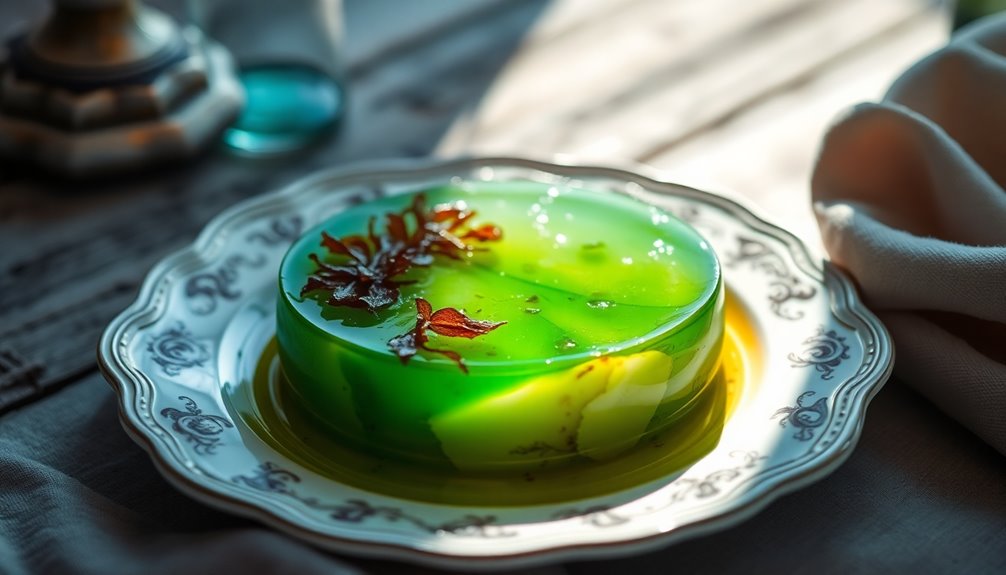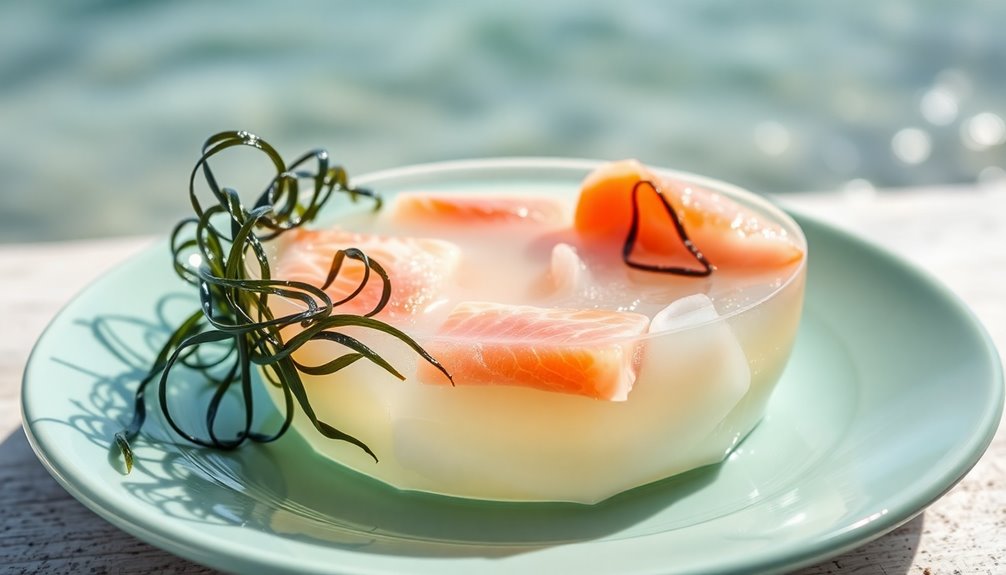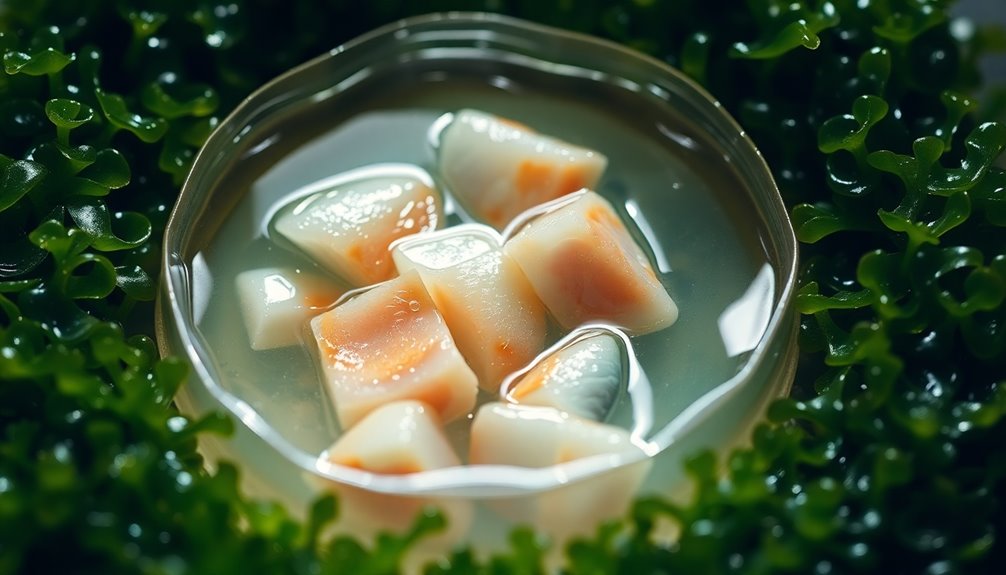Fish aspic with sea bay algae transforms a classic dish into a modern culinary delight. By using fresh fish, flavorful fish stock, and adding seaweed, you enhance both the taste and nutritional value of the aspic. This elegant presentation, often served chilled, is perfect for special occasions. With vibrant colors and a unique flavor profile, it's bound to impress. If you're curious about its history and detailed cooking steps, there's plenty more to explore!
History

Fish aspic has a rich history that reflects its cultural significance across various regions, particularly in Europe and Asia. This gelatinous dish, made from fish broth, has roots that stretch back to ancient times. Culinary texts reveal its popularity as a means of preserving food while creating elegant dishes for special occasions.
In Eastern European cuisine, dishes like Kholodets highlight regional ingredients and showcase generations of tradition, often featuring layers of fish or meat set in flavorful gelatin.
The evolution of fish aspic has seen it transition from humble origins to a refined presentation in modern gastronomy. Today, the incorporation of seaweed and algae not only adds nutrition but also enhances flavors, keeping this historical dish relevant in contemporary cooking.
Recipe

Fish aspic is a traditional dish that beautifully showcases the delicate flavors of fish combined with the unique texture of gelatin. It isn't only visually appealing but also a delightful addition to any dining table, especially during special occasions. This recipe incorporates the richness of fish, particularly those high in collagen like eel or carp, and enhances it with the briny notes of seaweed. The result is a luscious, savory dish that tantalizes the taste buds while providing a refreshing and elegant presentation.
To begin, you'll need to extract the natural gelatin from the fish by simmering it gently in water, which allows the flavors to meld and the collagen to dissolve. Once you have a flavorful broth, it's important to strain it to achieve a smooth texture before adding gelatin packets and finely chopped algae. Layering cooked fish pieces and fresh vegetables adds both depth and color to the aspic, making it not only a treat for the palate but also a feast for the eyes.
Ingredients:
- 1 kg fish (eel or carp)
- 2 liters water
- 3 packets of gelatin
- 100 g seaweed (finely chopped)
- 2 carrots (sliced)
- 200 g mushrooms (sliced)
- Salt and pepper to taste
- Lemon slices (for garnish)
- Fresh herbs (for garnish)
To prepare the fish aspic, start by placing the fish in a large pot with the water. Bring it to a gentle simmer and cook for about 1-2 hours, allowing the flavors to develop and the collagen to be released. Strain the broth and return it to the pot. Dissolve the gelatin packets in the warm broth, adding the finely chopped seaweed, salt, and pepper to taste.
In a serving dish, layer the cooked fish pieces, sliced carrots, and mushrooms. Pour the broth mixture over the layered ingredients and refrigerate until fully set, typically 4-6 hours or overnight.
When preparing fish aspic, it's important to use high-quality fish to ensure the best flavor and texture. Additionally, feel free to experiment with different vegetables or herbs to customize the dish to your taste. For an even more impressive presentation, use a mold to shape the aspic and serve it on a platter.
Lastly, don't forget to prepare a complementary sauce, such as horseradish or vinaigrette, to enhance the flavors when serving.
Cooking Steps

To make fish aspic, you'll start by preparing a flavorful fish stock that extracts all the goodness from bones and skin.
Once the stock is ready, strain it to remove any solids before adding gelatin to create that perfect texture.
Finally, chill the mixture until it sets, and don't forget to garnish it with fresh herbs for an eye-catching finish!
Step 1. Prepare the Fish Stock

Creating a rich fish stock is essential for a flavorful aspic. Start by boiling 3 cups of water in a pot; this will be your base.
To enhance the flavor, dissolve bouillon cubes in the boiling water, stirring until fully combined. Next, add seasoning ingredients like Worcestershire sauce, garlic powder, and a pinch of sugar for depth.
Incorporate vegetables such as carrots and mushrooms, cooking them until they're tender. Once they're ready, use a slotted spoon to remove them from the broth. The stock should be really good at this point.
Finally, strain the bouillon through cheese cloth to ensure you have a clear, gelatin-rich stock that'll actually make your aspic shine.
Step 2. Strain the Fish Stock

After your broth has simmered and developed rich flavors, it's time to strain the fish stock.
Let it cool slightly to avoid burns and make handling easier. Grab a fine-mesh sieve or some cheesecloth to separate the liquid from the solid fish parts and vegetables.
Pour the stock slowly through the sieve, allowing the liquid to flow while capturing any remaining solids. If you want an even clearer aspic, consider double-straining the stock by passing it through a second layer of cheesecloth.
This step is crucial because it ensures a smooth texture and enhances the final presentation of your aspic.
Take your time with this process; your dish will benefit from the effort.
Step 3. Add Gelatin to Mixture

Adding gelatin to your mixture is a crucial step in achieving the perfect fish aspic.
Start by heating your bouillon or stock until it simmers, making sure it's hot enough to dissolve the gelatin completely. Measure one packet of gelatin for every two cups of liquid for a firm texture.
Sprinkle the gelatin over the hot broth and let it bloom for a few minutes. This helps it dissolve evenly without clumping.
Stir gently until the gelatin is fully dissolved, ensuring there are no visible granules.
Once dissolved, pour the gelatin mixture into your aspic mold or dish, distributing it evenly.
Allow it to cool slightly before moving on to the next steps in the process.
Step 4. Chill Mixture Until Set

Once you've poured the gelatin mixture into your mold or dish, let it cool to room temperature. This step is crucial to ensure the mixture sets properly.
After it's cooled, pop it into the refrigerator and chill it for at least 4 to 6 hours. This allows the aspic to firm up, so it's easy to slice later. Make sure the broth is completely dissolved and free of air bubbles for a clear finish.
To check if it's set, gently shake the mold; it should hold its shape without any liquid sloshing around. Once it's firm to the touch, your aspic is ready to be unmolded onto a platter, waiting for the final touches before serving.
Step 5. Garnish With Fresh Herbs

As you prepare to garnish your fish aspic, fresh herbs like dill, parsley, and chives can truly elevate its flavor and presentation. Finely chop these herbs to distribute their bright, fresh flavors evenly throughout the aspic, ensuring each bite tantalizes the palate.
For an added touch, place a sprig of your chosen herb atop each serving, enhancing the visual appeal for gatherings or special occasions.
To bring in a splash of color and an aromatic finish, consider sprinkling microgreens or edible flowers alongside the herbs.
Remember, fresh herbs are key; they provide a vibrant taste and significantly enhance the dish's overall aesthetic.
Final Thoughts

While exploring the world of fish aspic, it's clear that incorporating ingredients like sea bay algae can elevate this traditional dish to new heights.
By enhancing the gelatinous fish broth with algae, you not only boost its flavor but also its nutritional profile. Sea bay algae adds a unique umami depth, making your fish aspic more appealing to modern tastes.
Plus, its vibrant colors can transform your dish into a stunning centerpiece for gatherings, sparking conversations about innovative culinary techniques.
Experimenting with algae aligns with the growing trend of incorporating sea vegetables, promoting both sustainability and creativity.
Embrace this fusion of tradition and innovation, and let your fish aspic become a delicious testament to contemporary gastronomy.
Frequently Asked Questions
Do People Still Eat Aspic?
Yes, people still eat aspic, though it's not as common in everyday meals.
You might find it in formal dining settings or at special occasions where its elegant presentation shines.
Many chefs are rediscovering aspic, using it to showcase culinary creativity and sustainability by turning leftovers into beautiful dishes.
While it may seem nostalgic, aspic's versatility keeps it alive in certain cultural contexts and niche culinary events.
How Do You Eat Aspic?
Imagine a shimmering, jewel-like dish sitting on your table, glistening under the light.
To eat aspic, you'll want to grab a fork or small spoon. Gently lift a portion, letting it slide over a warm bed of rice to melt and blend flavors.
Pair it with a zesty sauce or garnish it with fresh herbs for an extra pop. Enjoy it alongside crusty bread or crackers for a delightful culinary experience!









